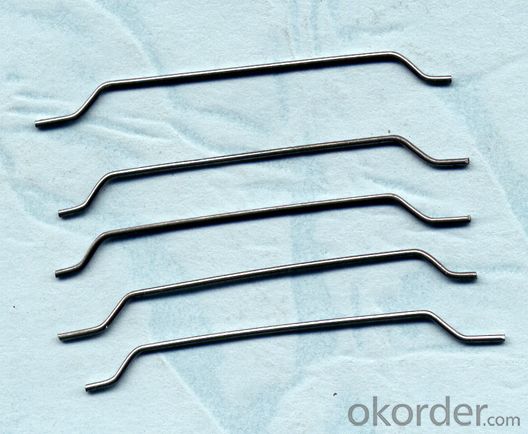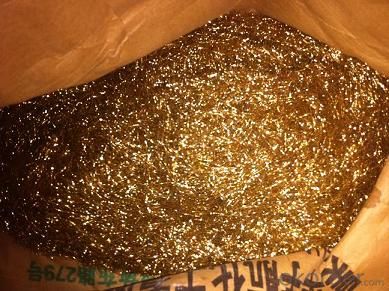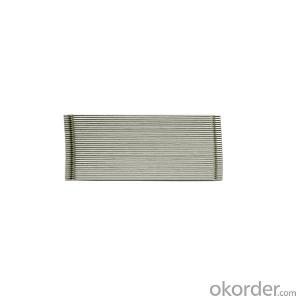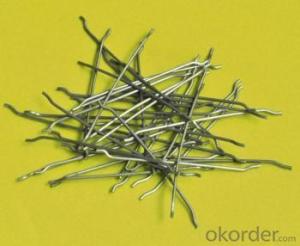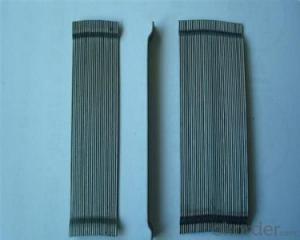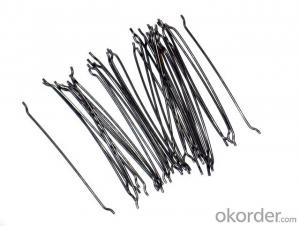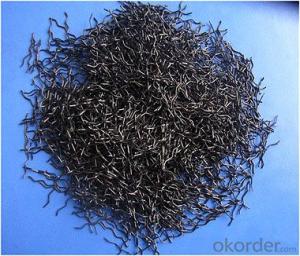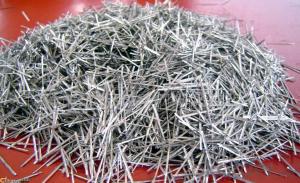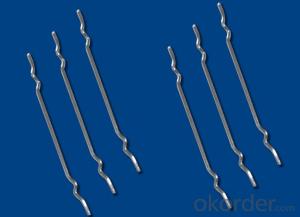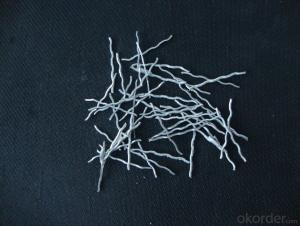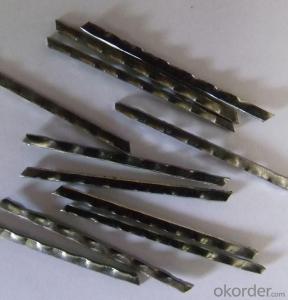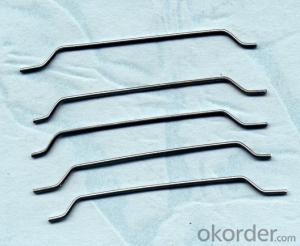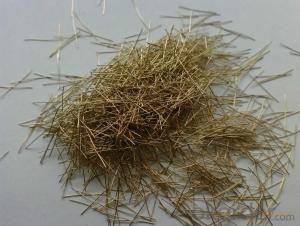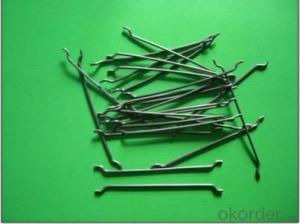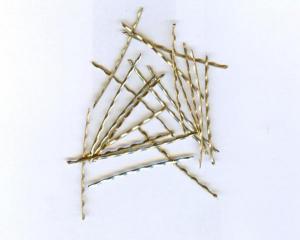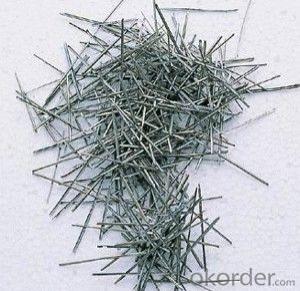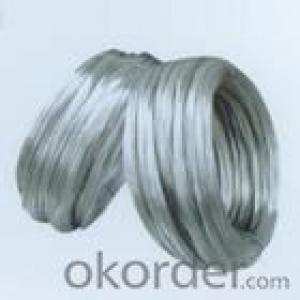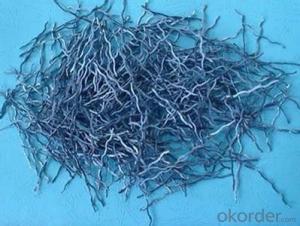Melt Extract Stainless Steel Fiber - Steel Fiber Copper Coated with Wire Diameter
- Loading Port:
- Tianjin
- Payment Terms:
- TT OR LC
- Min Order Qty:
- 1000 kg
- Supply Capability:
- 30000 kg/month
OKorder Service Pledge
OKorder Financial Service
You Might Also Like
Quick Details
Place of Origin: China (Mainland)
Model Number: HT-ST
Material: Steel
The Products
1>steel fiber
2>tensile strength: >1000Mpa
3>wire diameter:0.5mm-1mm
4>standard: ASTM A820
5>20 years factory
Specifications
Comparison of Steel fiber Reinforced Concrete and Ordinary Concrete
Item | Ordinary concrete | Steel fiber reinforced concrete | Enhancement rate |
C30(RC) | C30(SFRC) | (,%,) | |
Tensile strength | 3,5MPa | 5,39-7MPa | 54-100 |
Compressive strength | 31,2MPa | 32,5-40MPa | 4,4-28,2 |
Ultimate bending strength | 5,5MPa | 9,18-13,75MPa | 67-520 |
First crack bending strength | 4,88MPa | 7-8Mpa | 43-100 |
First crack strength | 8,85N,m | 23-53N,m | 160-500 |
Impact and fatigue strength | 5,96/cm2 | 53,3-91/m2 | 8-15 times |
Impermeability grade | P6~p12 | 0,5 ~2,5 times |
Reference for using the steel fiber reinforced concrete
Type of steel fiber reinforced concrete | length/mm | L/D |
For general purpose | 20~60 | 30~80 |
Jet concrete | 20~35 | 30~80 |
Joints of seismic frame | 35~60 | 50~80 |
Railway sleeper | 30~35 | 50~70 |
Layered composite pavement | 30~120 | 60~100 |
Proportion of steel fiber and concrete
Proportion for general projects:
Content of steel fiber | Sand percentage (%) | Water cement ratio | Slump (cm) | Unit amount (kg/m3) | ||||
Steel fiber | Cement | Gravel | Sand | Water | ||||
1—1.2 | 40 | 0.45 | 3—5 | 78 | 400 | 1233 | 819 | 180 |
Content of steel fiber | Sand percentage (%) | Water cement ratio | Slump (cm) | Unit amount (kg/m3) | ||||
Steel fiber | Cement | Gravel | Sand | Water | ||||
1.5—1.8 | 48 | 0.45 | 3—5 | 120 | 450 | 1210 | 1035 | 200 |
Picture
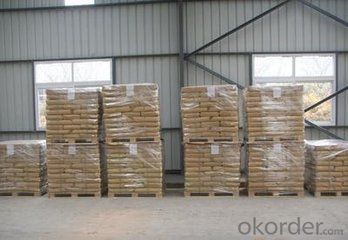
any type

pp bag
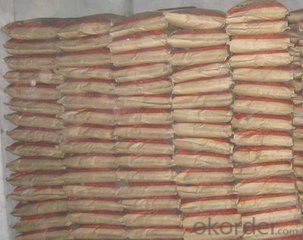
Steel fiber
FAQ
certificated: ISO 9001
Technical advantages of Daye steel fiber:
A. Improve mechanical performance of concrete
B. Provide uniform distribution throughout concrete with excellent mixing
C. No balling or caking by adopt correct mixing method
D. Reduce concrete volume
E.Save construction time and cost
F.Reduce excavation volume
G.Available for jointless floor.
- Q: Can melt extract stainless steel fiber be used in pre-stressed or post-tensioned concrete?
- Certainly! Melt extract stainless steel fiber is capable of being utilized in both pre-stressed and post-tensioned concrete. By incorporating stainless steel fibers into concrete, its tensile strength and resistance to cracking can be enhanced, rendering it suitable for applications like pre-stressed or post-tensioned concrete. The exceptional characteristics of stainless steel fibers, such as their high tensile strength, corrosion resistance, and durability, make them an ideal reinforcement material for concrete structures that experience substantial loads or potential cracking. Moreover, the melt extract stainless steel fibers can be effortlessly blended into the concrete mixture and evenly dispersed throughout the structure, ensuring uniform reinforcement. Consequently, melt extract stainless steel fibers represent a viable choice for reinforcing pre-stressed or post-tensioned concrete.
- Q: Does melt extract stainless steel fiber improve the resistance to chloride penetration in concrete?
- Yes, melt extract stainless steel fiber can improve the resistance to chloride penetration in concrete. Stainless steel fibers are known for their corrosion resistance, which makes them highly effective in protecting concrete structures from chloride attacks. Chloride ions can penetrate concrete and corrode the reinforcement, leading to structural deterioration. However, when stainless steel fibers are added to the concrete mix, they create a network that enhances the overall durability and resistance to chloride penetration. The fibers act as a barrier, hindering the movement of chloride ions and reducing their ability to reach the reinforcement. This results in improved resistance to chloride-induced corrosion in concrete, ultimately extending the service life of the structure.
- Q: Can melt extract stainless steel fiber be used in lightweight concrete mixtures?
- Yes, melt extract stainless steel fiber can be used in lightweight concrete mixtures. Stainless steel fibers are commonly added to concrete mixtures to enhance its durability, strength, and crack resistance. These fibers act as reinforcement, providing increased tensile strength and preventing the formation and propagation of cracks. The use of stainless steel fibers in lightweight concrete can help improve its overall mechanical properties while maintaining its lightweight characteristics. Additionally, the corrosion resistance of stainless steel fibers makes them suitable for long-term applications in concrete structures.
- Q: How does melt extract stainless steel fiber improve the fatigue resistance of concrete?
- Melt extract stainless steel fiber is known for enhancing the fatigue resistance of concrete due to its unique properties and characteristics. When added to concrete, these fibers create a three-dimensional reinforcement network that strengthens the material and improves its ability to withstand repetitive loading or cyclic stress. One of the main ways in which melt extract stainless steel fiber enhances the fatigue resistance of concrete is by increasing its crack resistance. As the concrete undergoes cyclic loading, cracks may develop and propagate, leading to eventual failure. However, the presence of stainless steel fibers helps to arrest the growth of these cracks, preventing them from spreading and improving the overall durability of the concrete. Moreover, the high tensile strength and excellent ductility of stainless steel fibers contribute to the fatigue resistance of concrete. These fibers can absorb and distribute stress throughout the concrete matrix, reducing the concentration of stress at specific points. This redistribution of stress helps to prevent the formation of microcracks and enhances the overall fatigue strength of the concrete. Additionally, the corrosion resistance of stainless steel fibers plays a crucial role in improving the fatigue resistance of concrete. Concrete is often exposed to harsh environmental conditions, such as moisture and chemical agents, which can lead to corrosion and deterioration of the material. However, stainless steel fibers are highly resistant to corrosion, ensuring the long-term integrity and durability of the concrete structure. Furthermore, melt extract stainless steel fibers also provide thermal stability to concrete. The expansion and contraction of concrete due to temperature variations can lead to the development of cracks and decrease its fatigue resistance. However, the presence of stainless steel fibers helps to minimize these thermal stresses by providing additional reinforcement and reducing the risk of crack formation. In conclusion, melt extract stainless steel fiber enhances the fatigue resistance of concrete through various mechanisms. It improves crack resistance, distributes stress, offers corrosion resistance, and provides thermal stability. By incorporating these fibers into concrete, the material becomes more resilient, durable, and capable of withstanding repetitive loading or cyclic stress, ultimately improving its fatigue resistance.
- Q: Is melt extract stainless steel fiber compatible with different types of admixtures?
- Yes, melt extract stainless steel fiber is compatible with different types of admixtures. This type of fiber is commonly used in concrete to enhance its mechanical properties, such as tensile strength and durability. The addition of admixtures to concrete can further improve its performance by modifying certain properties, such as workability, setting time, and water-cement ratio. Melt extract stainless steel fibers are highly versatile and can be used in combination with various admixtures. For example, if a plasticizing admixture is added to improve workability, the stainless steel fibers can still be incorporated without any negative effects. Similarly, if a superplasticizer is used to increase the flowability of concrete, the stainless steel fibers can be included without compromising the effectiveness of the admixture. It is important to note that the compatibility of melt extract stainless steel fibers with admixtures can vary depending on the specific fibers and admixtures being used. Therefore, it is always recommended to consult the manufacturer's guidelines and conduct proper testing to ensure compatibility and achieve the desired concrete properties.
- Q: What is the effect of melt extract stainless steel fiber on the plastic shrinkage of concrete?
- The effect of melt extract stainless steel fiber on the plastic shrinkage of concrete is that it helps reduce the occurrence of plastic shrinkage cracking. The fibers act as reinforcement within the concrete, improving its overall tensile strength and reducing the potential for shrinkage-related cracks. Additionally, the stainless steel fibers help to distribute stress more evenly throughout the concrete, minimizing the formation of shrinkage cracks caused by drying shrinkage.
- Q: Can melt extract stainless steel fiber be used in tunnel segmental lining?
- Yes, melt extract stainless steel fiber can be used in tunnel segmental lining. The use of stainless steel fiber in tunnel segmental lining offers several advantages. Firstly, stainless steel fibers provide enhanced tensile strength and durability to the tunnel lining, which is crucial for ensuring the structural integrity and longevity of the tunnel. Secondly, stainless steel fibers offer excellent resistance to corrosion, making them ideal for use in underground environments where exposure to moisture and chemicals is common. Additionally, the use of stainless steel fibers can help to reduce cracking and improve the overall performance of the tunnel lining by enhancing its resistance to shrinkage, thermal expansion, and other potential deformations. Therefore, melt extract stainless steel fiber is a suitable choice for tunnel segmental lining applications.
- Q: What is the typical aspect ratio of melt extract stainless steel fiber?
- The typical aspect ratio of melt extract stainless steel fiber is around 50:1 to 100:1. Aspect ratio refers to the length-to-diameter ratio of the fiber. In the case of melt extract stainless steel fiber, the length is typically 50 to 100 times greater than its diameter. This elongated shape helps enhance the mechanical properties and performance of the fiber in various applications such as reinforcement in composites, thermal management, and electromagnetic shielding.
- Q: Can melt extract stainless steel fiber be used in airport runways?
- Yes, melt extract stainless steel fiber can be used in airport runways. These fibers are highly durable and have high tensile strength, making them suitable for withstanding heavy traffic loads, including aircraft landings and take-offs. Additionally, stainless steel fibers are resistant to corrosion and can withstand extreme weather conditions, which is essential for airport runways exposed to various elements. Furthermore, the use of stainless steel fibers in airport runways can help enhance the overall performance and lifespan of the runway, reducing the need for frequent repairs and maintenance.
- Q: How does melt extract stainless steel fiber improve the resistance to cracking in concrete?
- The unique properties and characteristics of melt extract stainless steel fiber contribute to the improvement of crack resistance in concrete. By reinforcing the material, the fibers provide additional tensile strength and ductility when mixed into the concrete. Uniformly dispersed throughout the concrete matrix, the stainless steel fibers form a three-dimensional network that enhances the overall structural integrity. This network effectively distributes and absorbs stresses, preventing cracks from forming and spreading. Furthermore, the high aspect ratio of the fibers, combined with their strong bond to the concrete matrix, enhances the material's load-bearing capacity. As a result, the stainless steel fibers act as micro-reinforcements when exposed to external forces or thermal changes, effectively resisting crack formation and reducing crack width and length. The corrosion resistance of stainless steel fibers is also a significant advantage. Unlike other types of fibers, stainless steel does not corrode even in harsh environments or when exposed to chemicals. This corrosion resistance ensures the long-term durability of the concrete structure, preventing the deterioration of its mechanical properties. Moreover, the inclusion of melt extract stainless steel fibers reduces shrinkage and creep in concrete, which are common causes of cracking. As the concrete dries and cures, shrinkage occurs, often leading to cracks. However, the addition of stainless steel fibers minimizes overall shrinkage, reducing the potential for cracks to form. In conclusion, melt extract stainless steel fibers greatly enhance the crack resistance of concrete. These fibers improve tensile strength, ductility, load-bearing capacity, and corrosion resistance, resulting in a more durable and long-lasting concrete structure.
Send your message to us
Melt Extract Stainless Steel Fiber - Steel Fiber Copper Coated with Wire Diameter
- Loading Port:
- Tianjin
- Payment Terms:
- TT OR LC
- Min Order Qty:
- 1000 kg
- Supply Capability:
- 30000 kg/month
OKorder Service Pledge
OKorder Financial Service
Similar products
Hot products
Hot Searches
Related keywords




